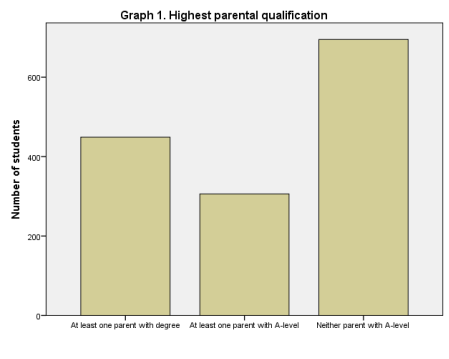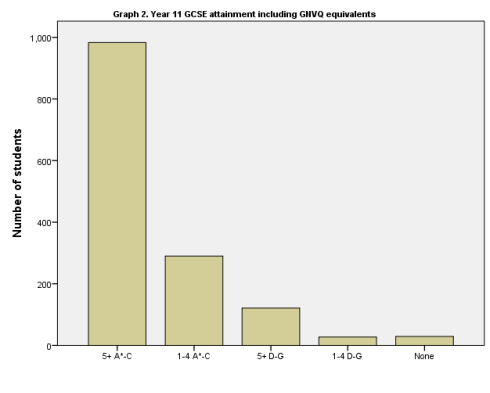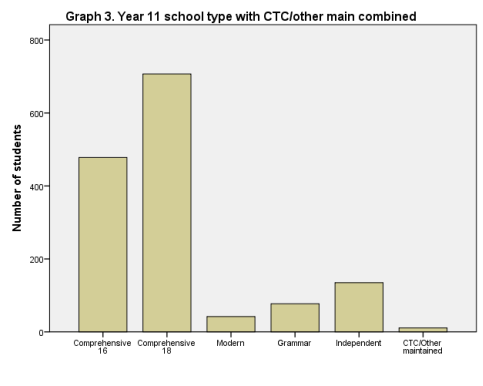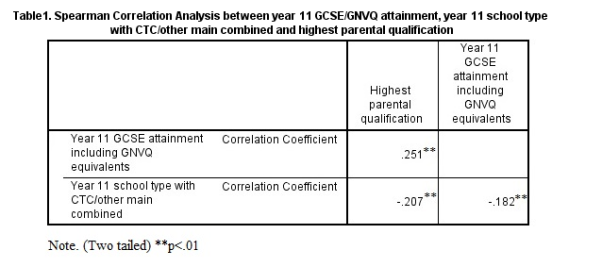15 Aug 2017 12 Sep 2017
Introduction
The data set resulted from measuring variables mostly focused on various GSCE grades, type of schools attended and family education levels and it is comprised of 1450 responses. Out of the 1450 participants, 57.2 percent were females (830 females) and 42.8 percent males (620 males) 16-year-old students from England, Wales and Northern Ireland. Furthermore, the objective of the analysis is to explore possible correlations between the three variables chosen (year 11 GCSE/GNVQ attainment, year 11 school type with CTC/other main combined and highest parental qualification). The data measured does not have equidistant units and the data is ordered categorically, therefore it is ordinal data. As the data analysed is ordinal data, it does not meet parametric assumptions and therefore have been analysed using non-parametric inferential measures. Parametric assumptions can only be met if the data analysed is scale, has equal variances and assume normality. It is expected to find a strong positive correlation between the highest parental qualification and year 11 GCSE/GNVQ attainment. This is due to parents being role models for the students which suggests that it is likely for students to be aiming to achieve the same level of education or higher than their role models. Nonetheless it is also likely that parents with higher education qualifications would be expecting their children to achieve the same level of education or higher than themselves and would encourage their children to strive and achieve the expected level of education (Sammons et al., 2014).
Methods
The first stage of the analysis was to look as descriptive statistics to better understand the gender ratio of the participants for demographic reasons as well as the frequency of the students within the three variables analysed. Furthermore, a non-parametric correlation analysis was conducted between year 11 GCSE/GNVQ attainment, year 11 school type with CTC/other main combined and highest parental qualification.
Results
In terms of highest parental qualification (Graph 1), 31 percent (449 participants) had at least one parent with a degree, whereas 21.1 percent (306 participants) had at least one parent with A-level and 47.9 percent (695 participants) where neither of the parents had A-level qualifications.


Also, when looking at the year 11 GCSE/GNVQ attainment (Graph 2), it can be observed that 67.8 percent of the participants have achieved 5+ A*-C scores, 20 percent of the students have achieved 1-4 A*-C scores, 8.3 percent achieved 5+ D-G scores, 1.9 percent have achieved 1-4 D-G scores and lastly 2 percent have not achieved any scores.

Furthermore, 48.8 percent of the participants (707) attended a Comprehensive 18 school in year 11, whilst 33 percent (478) attended a Comprehensive 16 school, 9.3 percent (135) attended an independent school, 5.3 percent (77) attended a grammar school, 2.9 percent (42) attended a modern school and 0.8 percent (11) attended a CTC/otherwise maintained school.
To determine if there is a relationship between year 11 GCSE/GNVQ attainment, year 11 school type with CTC/other main combined and highest parental qualification a Spearman Correlation analysis was conducted (Table 1). After running the analysis, three significant correlations with p< 0.01 (2-tailed) were identified: a positive correlation between highest parental qualification and 11 GCSE/GNVQ attainment (r= 0.251, n=1450, p<0.01); a negative correlation between highest parental qualification and year 11 school type with CTC/other main combined (r= -0.207, n=1450, p<0.01); and a negative correlation between year 11 GCSE/GNVQ attainment and year 11 school type with CTC/other main combined (r= -0.182, n=1450, p<0.01).

Discussion
As shown in the Spearman correlation, it is suggested that the higher the education level of at least one of the students' parents is, the higher the students' GCSE attainment is likely to be. On the other hand, the negative correlations suggest that the direction of the year 11 school type with CTC/other main combined is moving in the opposite direction to the other two variables 11 GCSE/GNVQ attainment and highest parental qualification. However, due to an unequal number of females and males, the possible correlation of the separate genders with results obtained for certain subjects is not a possibility. A further limitation of the study is that due to lack of control over all the variables, there may be confounding variables influencing the correlations. This is important as due to the lack of control over variables, the researcher cannot make assumptions about the correlations discovered after running a correlational analysis as to cause and effect of the relationship which is further problematic to the correlational analysis itself. A strength of the study is the large sample is the large sample of 1450 participants who are 16-year-old students from England, Wales and Northern Ireland used in the study. However, this can only be generalised to the population of 16-year-old students from England, Wales and Northern Ireland. Therefore, it would be ideal if the study could also be replicated using samples of 16-year-old students from different countries. However, a limitation to this would be that other countries would be using different educational structures and therefore an accurate replication would be almost impossible and this study could not be compared to future studies conducted in other countries. Therefore, establishing a common ground of different educational structures, would facilitate in-depth knowledge on correlations between other variables and education.
Another limitation of the study is that further information on the procedure and setting of the data collection which has not been provided alongside the data set limits the understanding of some possible confounding variables such as whether the setting of the data collection was done in a lab, whether the information about the parents' highest academic qualification was obtained from the students or the parents, whether the GSCE/GNVQ results were obtained from the educational institution or the students' themselves, etc. Furthermore, the reliability of the questions and procedures used to collect data included in the study cannot be determined due to the above pieces of information not being provided as for example, if certain data such as results have been collected directly from the participants, they might have given untruthful answers. Future research on the same or similar educational aspects could consider different variables such as the consistency of results across the years, the time spent on focusing to achieve the results as well, stressful experiences which may have impacted on academic performance, different aspects of the ability to learn experienced by the students, the students' interest in the subjects and the support received from teachers and parents. Achieving a more in debt knowledge about these confounding variables would be ideal towards understanding whether these correlations are momentary or whether the correlations are constant for a certain time scale. Another advantage of conducting a longitudinal study is that it may be able to record the coping and learning styles preferred by the students in contrast to the coping and learning styles used.
References
Sammons, P., Sylva, K., Melhuish, E., Siraj, I., Taggart, B., Toth, K., & Smees, R. (2014). Influences on students' GCSE attainment and progress at age 16. London: University of London.


Then shoot us a message on Whatsapp, WeChat or Gmail. We are available 24/7 to assist you.

Visit Our essay writting help page to get all the details and guidence on availing our assiatance service.
Our writting assistance service is undoubtedly one of the most affordable writting assistance services and we have highly qualified professionls to help you with your work. So what are you waiting for, click below to order now.
Our experts are ready to assist you, call us to get a free quote or order now to get succeed in your academics writing.